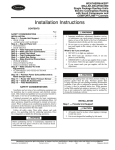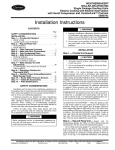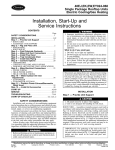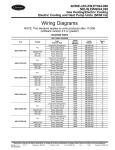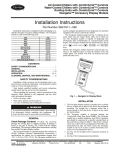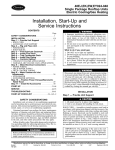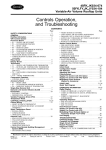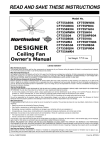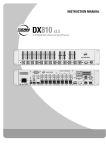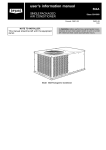Download Carrier 48AK Specifications
Transcript
48AJ,AK,AW,AY020-060 with Reciprocating Compressor 48EJ,EK,EW,EY024-068 Single Package Rooftop Units Electric Cooling/Gas Heating Installation, Start-Up and Service Instructions CONTENTS Page SAFETY CONSIDERATIONS . . . . . . . . . . . . . . . . . . . . . . 1 INSTALLATION . . . . . . . . . . . . . . . . . . . . . . . . . . . . . . . . 1-58 Step 1 — Provide Unit Support . . . . . . . . . . . . . . . . . . . 1 • ROOF CURB • ALTERNATE UNIT SUPPORT Step 2 — Rig and Place Unit . . . . . . . . . . . . . . . . . . . . . 2 • POSITIONING • ROOF MOUNT Step 3 — Field Fabricate Ductwork . . . . . . . . . . . . . . . 2 Step 4 — Make Unit Duct Connections . . . . . . . . . . . 2 Step 5 — Install Flue Hood . . . . . . . . . . . . . . . . . . . . . . 28 Step 6 — Trap Condensate Drain . . . . . . . . . . . . . . . . 28 Step 7 — Install Gas Piping . . . . . . . . . . . . . . . . . . . . . 28 Step 8 — Controls Options . . . . . . . . . . . . . . . . . . . . . . 29 • STAGED GAS UNIT APPLICATIONS • THERMISTORS • CONSTANT VOLUME APPLICATIONS • VARIABLE AIR VOLUME (VAV) APPLICATIONS Step 9 — Make Electrical Connections . . . . . . . . . . 33 • POWER WIRING • FIELD POWER SUPPLY • FIELD CONTROL WIRING Step 10 — Make Outdoor-Air Inlet Adjustments . . . . . . . . . . . . . . . . . . . . . . . . . . . . . . . . . . 48 • ECONOMIZER • ECONOMIZER SETTINGS Step 11 — Position Power Exhaust/Barometric Relief Damper Hood. . . . . . . . . . . . . . . . . . . . . . . . . . . 52 Step 12 — Install All Accessories . . . . . . . . . . . . . . . 54 Step 13 — Field Modifications. . . . . . . . . . . . . . . . . . . 57 START-UP . . . . . . . . . . . . . . . . . . . . . . . . . . . . . . . . . . . . 58-89 SERVICE . . . . . . . . . . . . . . . . . . . . . . . . . . . . . . . . . . . . 89-102 TROUBLESHOOTING. . . . . . . . . . . . . . . . . . . . . . . 103-115 START-UP CHECKLIST . . . . . . . . . . . . . . . . . . . CL-1,CL-2 SAFETY CONSIDERATIONS Installation and servicing of air-conditioning equipment can be hazardous due to system pressure and electrical components. Only trained and qualified service personnel should install, repair, or service air-conditioning equipment. Untrained personnel can perform the basic maintenance functions of cleaning coils and filters and replacing filters. All other operations should be performed by trained service personnel. When working on air-conditioning equipment, observe precautions in the literature, tags and labels attached to the unit, and other safety precautions that may apply. Follow all safety codes. Wear safety glasses and work gloves. Use quenching cloth for unbrazing operations. Have fire extinguishers available for all brazing operations. Before performing service or maintenance operations on unit, turn off main power switch to unit. Electrical shock could cause personal injury. 1. Improper installation, adjustment, alteration, service, or maintenance can cause property damage, personal injury, or loss of life. Refer to the User’s Information Manual provided with this unit for more details. 2. Do not store or use gasoline or other flammable vapors and liquids in the vicinity of this or any other appliance. What to do if you smell gas: 1. DO NOT try to light any appliance. 2. DO NOT touch any electrical switch, or use any phone in your building. 3. IMMEDIATELY call your gas supplier from a neighbor’s phone. Follow the gas supplier’s instructions. 4. If you cannot reach your gas supplier, call the fire department. Disconnect gas piping from unit when pressure testing at pressure greater than 0.5 psig. Pressures greater than 0.5 psig will cause gas valve damage resulting in hazardous condition. If gas valve is subjected to pressure greater than 0.5 psig, it must be replaced before use. When pressure testing field-supplied gas piping at pressures of 0.5 psig or less, a unit connected to such piping must be isolated by closing the manual gas valve(s). INSTALLATION Step 1 — Provide Unit Support 1. All panels must be in place when rigging. 2. Unit is not designed for handling by fork truck. Manufacturer reserves the right to discontinue, or change at any time, specifications or designs without notice and without incurring obligations. PC 111 Catalog No. 534-739 Printed in U.S.A. Form 48A,E-1SI Pg 1 107 11-01 Replaces: 48E-6SI Book 1 Tab 1a When unit is located adjacent to public walkways, flue assembly must be at least 7 ft above grade. ROOF MOUNT — Check building codes for weight distribution requirements. See Fig. 17. Unit operating weight is shown in Table 2. ROOF CURB — For vertical discharge units, assemble or install accessory roof curb in accordance with instructions shipped with this accessory. See Fig. 1-4. Install insulation, cant strips, roofing, and counter flashing as shown. Ductwork can be installed to roof curb before unit is set in place. Curb should be level. This is necessary to permit unit drain to function properly. Unit leveling tolerance is shown in Fig. 1-3. Refer to Accessory Roof Curb Installation Instructions for additional information as required. When accessory roof curb is used, unit may be installed on class A, B, or C roof covering material. Step 3 — Field Fabricate Ductwork — Secure all ducts to building structure. Use flexible duct connectors between unit and ducts as required. Insulate and weatherproof all external ductwork, joints, and roof openings with counter flashing and mastic in accordance with applicable codes. NOTE: Due to width of the horizontal supply/return ductwork, provisions should be made for servicing of the outdoor air filters (i.e., catwalk over ductwork). Ducts passing through an unconditioned space must be insulated and covered with a vapor barrier. Outlet grilles must not lie directly below unit discharge. The return duct must have a 90-degree elbow before opening into the building space if the unit is equipped with power exhaust. To attach ductwork to roof curb, insert duct approximately 10 to 11 in. up into roof curb. Connect ductwork to 14-gage roof curb material with sheet metal screws driven from inside the duct. IMPORTANT: The gasketing of the unit to the roof curb is critical for a watertight seal. Install gasket with the roof curb as shown in Fig. 1-3. Improperly applied gasket can also result in air leaks and poor unit performance. ALTERNATE UNIT SUPPORT — When the preferred curb or slab mount cannot be used, support unit with sleepers on perimeter, using unit curb support area. If sleepers cannot be used, support long sides of unit (refer to Fig. 5-16) with a minimum number of 4-in. x 4-in. pads spaced as follows: 48AJ,AK,AW,AY020-030 and 48EJ,EK,EW,EY024-034 units require 3 pads on each side; 48AJ,AK,AW,AY035-050 and 48EJ,EK,EW,EY038-048 units require 4 pads on each side; 48AJ,AK,AW,AY060 and 48EJ,EK,EW,EY054-068 units require 6 pads on each side. Unit may sag if supported by corners only. For vertical supply and return units, tools or parts could drop into ductwork and cause an injury. Install a 90-degree elbow turn in the supply and return ductwork between the unit and the conditioned space. If a 90-degree elbow cannot be installed, then a grille of sufficient strength and density should be installed to prevent objects from falling into the conditioned space. Step 2 — Rig and Place Unit — Inspect unit for transportation damage. See Tables 1A and 1B for physical data. File any claim with transportation agency. Do not drop unit; keep upright. Use spreader bars over unit to prevent sling or cable damage. Level by using unit frame as a reference; leveling tolerance is shown in Fig. 1-3. See Fig. 17 for additional information. Unit operating weight is shown in Table 2. NOTE: On retrofit jobs, ductwork may be attached to old unit instead of roof curb. Be careful not to damage ductwork when removing old unit. Attach existing ductwork to roof curb instead of unit. Four lifting lugs are provided on the unit base rails as shown in Fig. 5-16. Refer to rigging instructions on unit. POSITIONING — Maintain clearance, per Fig. 5-16, around and above unit to provide minimum distance from combustible materials, proper airflow, and service access. Do not install unit in an indoor location. Do not locate unit air inlets near exhaust vents or other sources of contaminated air. For proper unit operation, adequate combustion and ventilation air must be provided in accordance with Section 5.3 (Air for Combustion and Ventilation) of the National Fuel Gas Code, ANSI Z223.1 (American National Standards Institute). Although unit is weatherproof, guard against water from higher level runoff and overhangs. Locate mechanical draft system flue assembly at least 4 ft from any opening through which combustion products could enter the building, and at least 4 ft from any adjacent building. Step 4 — Make Unit Duct Connections 48AJ,AK,EJ,EK UNITS — Unit is shipped for through-thebottom duct connections. Field-fabricated ductwork should be attached to the roof curb. Supply and return duct dimensions are shown in Fig. 5-7 and 11-13. Air distribution is shown in Fig. 18 and 19. Refer to installation instructions shipped with roof curb for more information. 48AW,AY,EW,EY UNITS — Remove shipping covers from supply and return air openings. Attach field-supplied ductwork to unit. Connect to the unit with a single duct for all supply openings and with a single duct for all return openings. Splitting of the airflow into branch ducts should not be done at the unit. Sufficient duct length should be used prior to branching to ensure the air temperatures are well mixed within the ductwork. See Fig. 8-10 and 14-16 for duct opening dimensions. Secure all ducts to building structure. Air distribution is shown in Fig. 8-10 and 14-16. Install accessory barometric relief or power exhaust in the field-fabricated return ductwork. Refer to Step 11 — Position Power Exhaust/Barometric Relief Damper Hood section on page 52 for more information. Instructions continued on page 28. 2 3 Fig. 1 — Roof Curb — 48AJ,AK020-030 and 48EJ,EK024-034 Units Preview Limit Reached! To view more of this manual, please visit: http://freemanualdownload.com/Carrier-48AK-free-man ual-download





